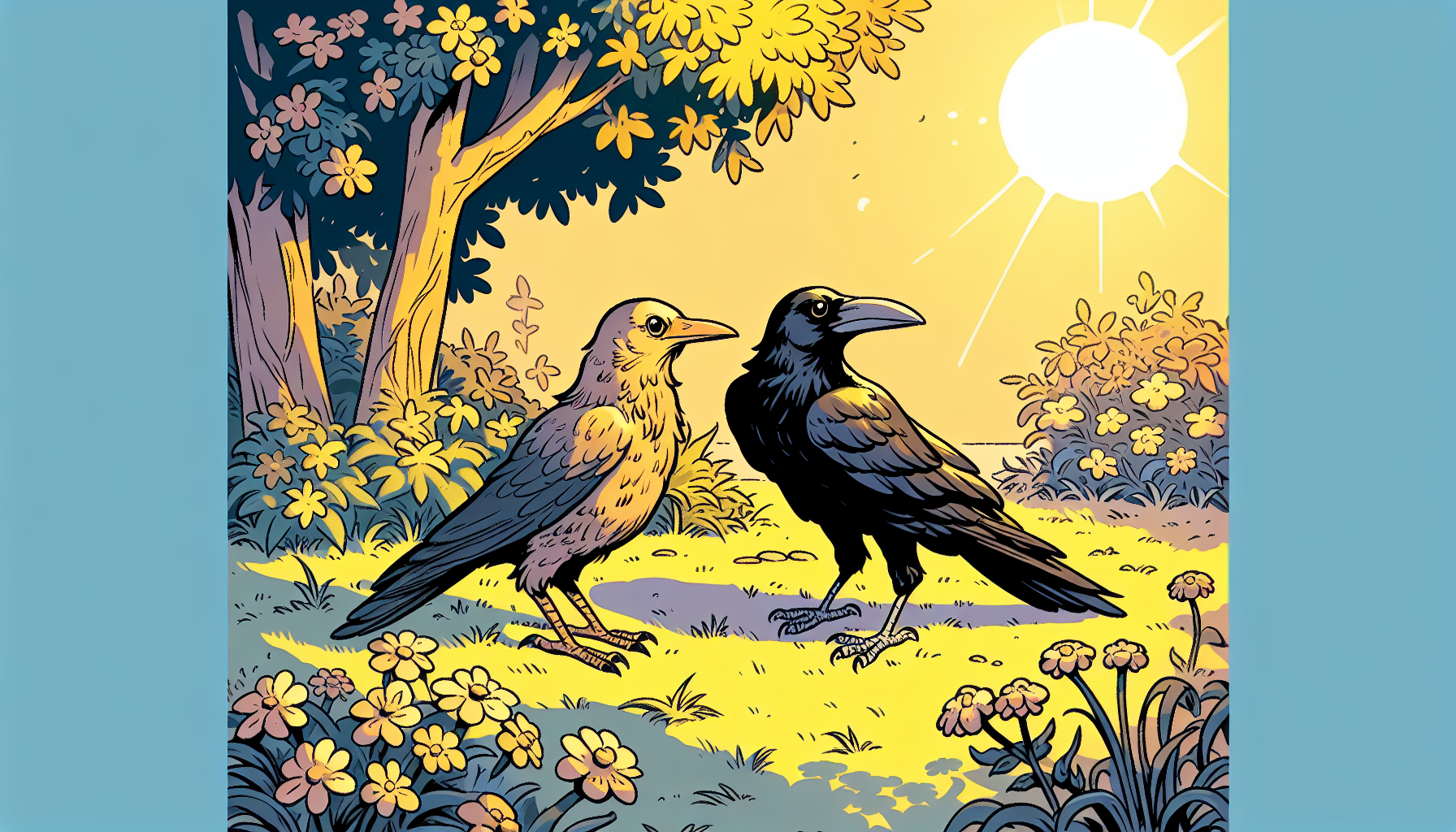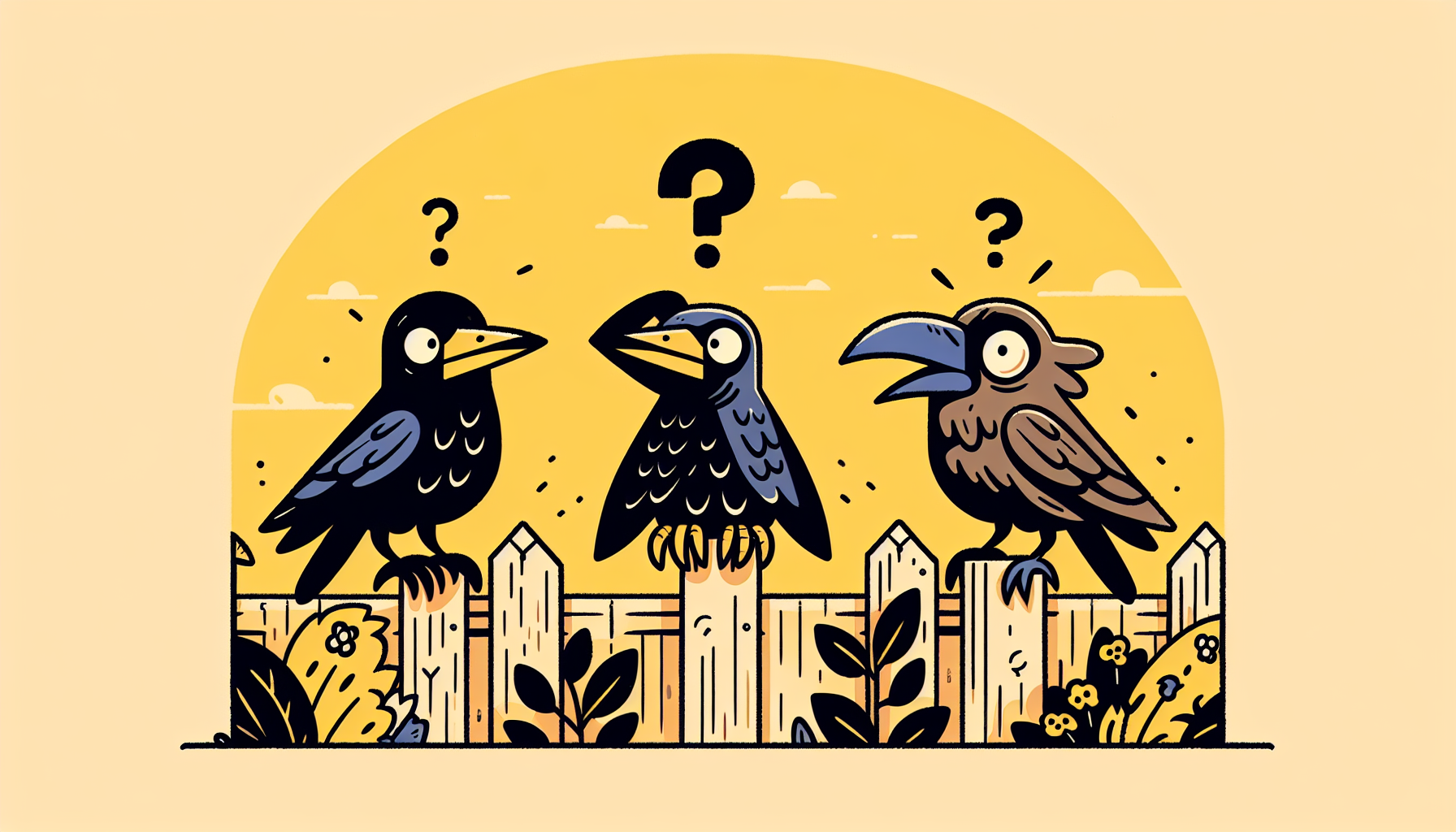
Difference between crow and raven
What is the difference between a crow and a raven? This question often arises when two large black birds circle over fields or call in the city park. In everyday life in Germany, the term "crow" usually refers to the carrion crow, rook or jackdaw, while "raven" almost always refers to the common raven. For birdwatchers, young families and all nature lovers, it is worth paying systematic attention to size ratios, tail shape, voice and behavior. This makes it easy to identify them in the garden, on the outskirts of town or on a weekend trip to the low mountain range.

This guide explains the most important external characteristics, presents the species relevant in Germany and shows how call, flight pattern and behavior help with identification. There are also practical tips for observations in your own garden - including tips on how smart solutions such as a bird feeder with camera or a nesting box with camera with AI bird recognition can reliably document observations.
TL;DR - The most important facts in brief
- The most common everyday "raven" in Germany is the common raven; "crow" usually means carrion crow (crow) or rook.
- Body size, wedge-shaped tail and deep "Kroaar" speak for the common raven; slimmer body, fan-shaped tail and "Krääh" for crow species.
- In urban areas, carrion crows occur singly or in pairs, rooks often in colonies; ravens prefer open landscapes close to forests and rocky slopes.
- The flight pattern is a top feature: ravens with a wedge-shaped tail and broad, "finger-like" hand wings; crows with a straighter, fan-shaped tail.
How do crows and ravens differ at first glance?
If you want to quickly recognize the difference between crows and ravens, first pay attention to size, tail shape, beak proportions and voice. The common raven is the largest songbird in Europe, looks massive, has a thick, slightly curved beak and a clearly wedge-shaped tail in flight. Carrion crows and rooks are smaller, slimmer and have a rather straight, fan-shaped tail in flight.
Body size and proportions
Raven reach a body length of approx. 59-67 cm and a wingspan of approx. 115-130 cm (orientation values). Carrion crows are approx. 44-51 cm long and have a wingspan of approx. 84-100 cm; rooks are approx. 44-46 cm long and have a wingspan of approx. 81-99 cm. The silhouette of the common raven appears "heavier" overall, with a deep chest and a pronounced strong neck.
Tail shape and flight pattern
In direct comparison, the most striking feature of the common raven is its wedge-shaped tail, which tapers towards the back. In crows, the tail appears rather straight and fan-shaped in flight. Common ravens glide more frequently, show elegant gliding phases and thermally supported circles, while crows are usually more vigorously flapping.
Beak, plumage and neck feathers
The raven's beak is large, massive and slightly curved; it has elongated feathers ("throat beard") on the throat, which are noticeably raised during courtship and calling. The plumage has a metallic sheen. Carrion crows are usually deep black (crow) or contrasting gray-black (hooded crow), rooks often have an unfeathered, lighter beak base in adults - an important detail outside the breeding season.
Which species are meant by "crow" and "raven" in Germany?
Everyday language and technical language differ: "crow" is colloquial, as is "raven". In ornithology, both belong to the corvids (Corvidae). The central species are the carrion crow, rook, jackdaw and raven. If you want to distinguish between crows and ravens, you should be familiar with these four key species.
Carrion crow: crow and hooded crow
The carrion crow occurs as a crow (all black) and hooded crow (gray-black). In Germany, the carrion crow dominates, while the hooded crow is mainly found in the north-east and east. Carrion crows are cultural followers, intelligent, adaptable and can be found in settlements, parks and agricultural landscapes.
In contrast to the carrion crow, rooks often form large breeding colonies in trees, often on the outskirts of villages. Adult birds have an unfeathered, light-colored beak base. Their calls sound more nasal. In the winter months, large flocks congregate on farmland and meadows.
Jackdaw
The jackdaw is smaller, with light eyes and a gray neck. It is very sociable and uses the crevices of buildings, church steeples or nesting boxes as breeding sites. In everyday life, it is also sometimes called a "crow", but is significantly smaller and more agile than a crow.
Raven
The common raven is the "real raven" in German. It prefers structurally rich open landscapes with adjoining forests and rocky areas, occupies large territories and displays conspicuous courtship flights with swoops and rolls. Its deep call carries far and can be heard from a great distance.
Practical tip: When flying against the light or from a great distance, the tail shape is often the most reliable feature for distinguishing between crows and ravens. Wait briefly until the bird glides - then the silhouette is the deciding factor.
Crow and raven difference in sound: How do the calls sound?
Acoustics help, especially in urban situations: Carrion crows call harshly "Krääh", varying pitch and rhythm; rooks sound more nasal, "croaking". Raven calls are deeper, "croaking" or rumbling, often with a vibrating resonance. The call dynamics of ravens are also distinctive: stanzas are combined with flight interludes during courtship.
When is listening particularly helpful?
Calls are particularly clear in the early morning and towards the evening. During the breeding season, activity in the territory increases; rooks are almost constantly busy at colony sites. Intelligent audio functions of some cameras can automatically mark time windows with increased call activity (orientation value) - a practical addition to field notes.
Where do crows and ravens live in Germany - and when are they most frequently seen?
Carrion crows are present almost everywhere: towns, villages, parks, fields. Rooks prefer agricultural landscapes with tall trees for colonies, but they do venture into towns and villages. Rooks require larger, less disturbed territories; the chances increase in low mountain ranges, on coastal cliffs or in densely wooded regions. Sightings are more frequent in the winter months at garbage and food sources and in harvested fields.
Seasonal patterns
- Spring (approx. March-May): Territorial behavior, nest building, frequent call contact.
- Summer (approx. June-August): Family groups, begging calls from young birds.
- Autumn/winter (approx. September-February): larger flocks, communal roosts; rooks in colonies on roosting trees.
How do you recognize the difference between crows and ravens in flight?
In the open air, aerodynamics play the main role: ravens show broad, rounded wings with "finger-like" hand wings and long gliding phases, often carried in a slight V-shape. Crows appear more compact, with faster wing beat and short gliding passages. A quick glance at the tip of the tail is often enough: pointed = raven; straight/fan-shaped = crow.
Intelligence, tool use and problem solving: What separates and connects them?
Ravens are among the most intelligent birds. Both crows and ravens show complex social behavior, learn quickly and solve problems. Differences lie more in habitat selection and social systems: Rooks as colony breeders with pronounced group coordination, carrion crows opportunistically in cities, ravens territorially with spectacular courtship flights and call dialogs. In experiments, both groups demonstrate memory skills and creative foraging.
The advantage for observers: intelligent birds repeat patterns. If you document approach times, feeding preferences and call frequency, you will soon recognize stable routines (orientation values), which further confirms the identification.
Practical tips for the garden and balcony: How to identify birds
- 1 Look for the tip of the tail when approaching: Wedge (raven) vs. fan (crow). Wait briefly until the bird glides - then decide.
- 2 Record or make a note of calls: deep "Kroaar" speaks for common ravens; harsh "Krääh" or nasal sounds for crows.
- 3 Pay attention to social behavior: Rooks in troops/colonies; carrion crows usually in pairs; common ravens territorial and in pairs.
- 4 Smart documentation: A bird feeder with camera records approach times, photos and short clips. With AI bird recognition, crow visits are distinguished from e.g. jays (orientation value).
- 5 Observe nesting possibilities: A bird nesting box with Camera provides insights into the breeding behavior of jackdaws and carrion crows in suitable regions; common ravens tend to use large nests (orientation values).
- 6 Feed only in moderation: Grains, oatmeal, nuts (unsalted) are suitable in small quantities; avoid food scraps. Cleanliness reduces the risk of disease.
Legal framework and protection status in Germany
All wild European bird species are protected under the Federal Nature Conservation Act. This means that special attention must be paid to nests, clutches and young birds all year round; disturbance of the brood must be avoided. Controlled feeding in winter is common in many places, but should be moderate (orientation value). In the event of conflicts, such as colony breeding of rooks in the village, the responsible authorities decide - unauthorized interventions are taboo.
Culture and symbolism: Why "ravens" seem mysterious
In myths and stories, ravens stand for wisdom, foresight and sometimes disaster. The deep call and size of the raven characterize this perception. Crows are considered shrewd and adaptable, which is reflected in urban legends about "clever city crows". The cultural context explains why all large, black corvids are often colloquially referred to as "ravens".
Case studies from the field: How it was correctly determined
City park in spring
Two black birds arguing loudly at a garbage can. Hard call "Krääh", slender body, fan-shaped tail: a pair of carrion crows. At the edge a group with nasal sounds - rooks on migration (orientation value: March/April).
Mid-mountain ridge in fall
Large black bird soaring on a slope, calling low "Kroaar", showing wedge-shaped tail and swooping flight with rolls: Raven. Further away, a group of smaller, faster-fluttering birds over a field - rooks looking for food.
Checklist: Crow and raven difference at a glance
- Size/proportions: Raven significantly bulkier.
- Tail: wedge-shaped (raven) vs. fan-shaped (crow).
- Beak: strong, curved (raven) vs. slender (crows); rook with unfeathered beak base (adult).
- Call: deep "Kroaar" (raven) vs. "Krääh" or nasal (crows).
- Social behavior: Rook colonies; carrion crows pairs; Raven territorial.
- Habitat: Cities/fields (crows) vs. large, less disturbed regions (raven).
Conclusion: Use the crow and raven difference safely

If you concentrate on a few key characteristics - tail shape, voice, proportions and social behavior - you can reliably recognize the difference between crows and ravens in Germany. Common ravens are larger, with a wedge-shaped tail and a deep "kroaar", while carrion crows and rooks are smaller, have a fan-shaped tail and a brighter or more nasal voice.
For beginners and families, a combination of targeted observation at fixed times of day and technical support is recommended: a bird feeder with a camera or a bird nesting box with a camera with integrated AI bird recognition automatically documents visitors by photo/video (orientation values) and facilitates comparison with identification features - without having to stand next to them all the time.
With a little practice, an eye for silhouettes and the support of smart cameras, you can identify birds in the garden, park or open field - and turn birdwatching into an exciting nature experience for young and old.
